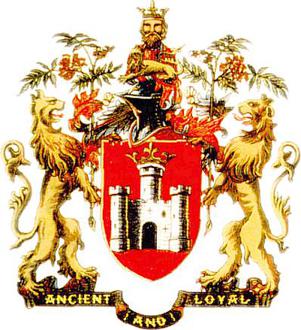Related Research Articles
The West Lancashire Football League is a football competition based in northern England, consisting of five divisions – three for first teams, and two for reserve teams. The league is currently sponsored by Lancaster-based radio station The Bay. The top division, the Premier Division, sits at step seven of the National League System and is a feeder league for the North West Counties Football League, although promotion and relegation is based upon application to the National League System Panel.

Morecambe is a seaside town and civil parish in the City of Lancaster district in Lancashire, England. It is located in Morecambe Bay on the Irish Sea.

The History of the Wigan Warriors stretches back to the club's foundation in 1872. It was one of the founding members of the Northern Rugby Football Union after the schism from the one code of rugby football in 1895. At the elite competition level, Wigan is the most successful club in the history of British Rugby League, measured by total of trophies won. The club has won 22 Rugby Football League Championships, 20 Challenge Cups and 4 World Club Challenge trophies.

James Leytham, also known by the nickname of "Gentleman Jim", was an English professional rugby league footballer who played in the 1890s, 1900s and 1910s. He played at representative level for Great Britain, England and Lancashire, and at club level for Lancaster and Wigan (captain), as a wing, i.e. number 2 or 5.
The 1900–01 Northern Rugby Football Union season was the sixth season of rugby league football.
The 1901–02 Northern Rugby Football Union season was the seventh season of rugby league football run by England's Northern Rugby Football Union. A number of off-season changes made this season different from preceding ones. In June 1901 fourteen leading clubs from both Lancashire and Yorkshire resigned from their respective senior competitions to form a new Northern Rugby Football League.
Wilfred Hodder was a Welsh dual-code international rugby union, and professional rugby league footballer who played in the 1910s and 1920s, and rugby league administrator. He played representative level rugby union (RU) for Wales, and at club level for Talywain RFC and Pontypool RFC, as a lock, i.e. number 4 or 5, and representative level rugby league (RL) for Wales, and at club level for Wigan, as a prop, or second-row, i.e. number 8 or 10, or, 11 or 12, during the era of contested scrums, and he was a member of the board of directors at Wigan RLFC.
Altrincham was a semi-professional rugby league club based in Altrincham, Cheshire, England.
Normanton is an amateur rugby league club based in Normanton, a small town within the City of Wakefield in West Yorkshire, England.
Tyldesley was a rugby league club in Tyldesley, Lancashire, England.
Birkenhead Wanderers was a semi-professional rugby league club in Birkenhead, England. They became members of the Northern Rugby Football Union and played for three full seasons from 1901–02 to 1903–04
Morecambe Rugby Football Club was a semi-professional rugby league club. The club was based in Morecambe, a resort town now within the City of Lancaster in Lancashire, England.
Leeds Parish Church RFC was a semi-professional rugby league club based in Leeds, West Yorkshire, England. The club played semi-professional rugby league for a total of five seasons from 1896–97 to 1900–01. Each of the five seasons was spent in the Yorkshire Senior Competition. At the end of season 1900–01 the club withdrew from the league.
South Shields was a semi-professional rugby league club. The club was based in South Shields in Tyne and Wear at the mouth of the River Tyne, England.
Stockport RFC was a Rugby League club in Stockport, Cheshire, England.
Castleford RFC was a semi-professional rugby league club based in Castleford in the West Riding of Yorkshire, England. They joined the Northern Union in 1896–97 for its second season and remained in the ranks of the (semi) professionals until the end of the 1905–06 season.
Liversedge RFC were a semi-professional rugby league club from Liversedge, Yorkshire, England. They were a founder member of the Northern Rugby Football Union, precursor to the Rugby Football League.
The North West Men's League is a rugby league competition for clubs in the North West of England. It is a successor league for the Rugby League Conference also comprising clubs from the North West Counties League following most of the latter switching to summer to follow the National Conference League.

Brighouse Rangers was a rugby league club in Brighouse, West Yorkshire, England.
Runcorn FC was a rugby league club. Having formed in 1876 and played rugby union as members of the RFU, they joined the Northern Union in 1895, just several days after it was founded, and played in the league from 1895–96 to 1917–18.
References
- 1 2 "Jim Lytham".
- ↑ J C Lindley with personal recollections by D W Armitage (1973). 100 Years of Rugby - The History of Wakefield Trinity Football Club. The Wakefield Trinity Centenary Committee. pp. 37 and 38.
- 1 2 3 4 "Heysham Atoms ARLFC".
- 1 2 3 "Preview of centenary match". Archived from the original on 27 September 2011. Retrieved 11 August 2011.
- ↑ Jack Winstanley & Malcolm Ryding (1975). John Player Rugby League Yearbook 1975–76. Queen Anne Press.
- 1 2 3 4 "Cherry and White".
- ↑ "Hull&Proud Fixtures & Results". Archived from the original on 2 March 2012.
- ↑ "Warrington Wolves results and archives". Archived from the original on 21 December 2011.
- 1 2 3 4 5 6 7 8 9 "Saints Heritage Society".
- 1 2 3 "Widnes Seasons in Review".